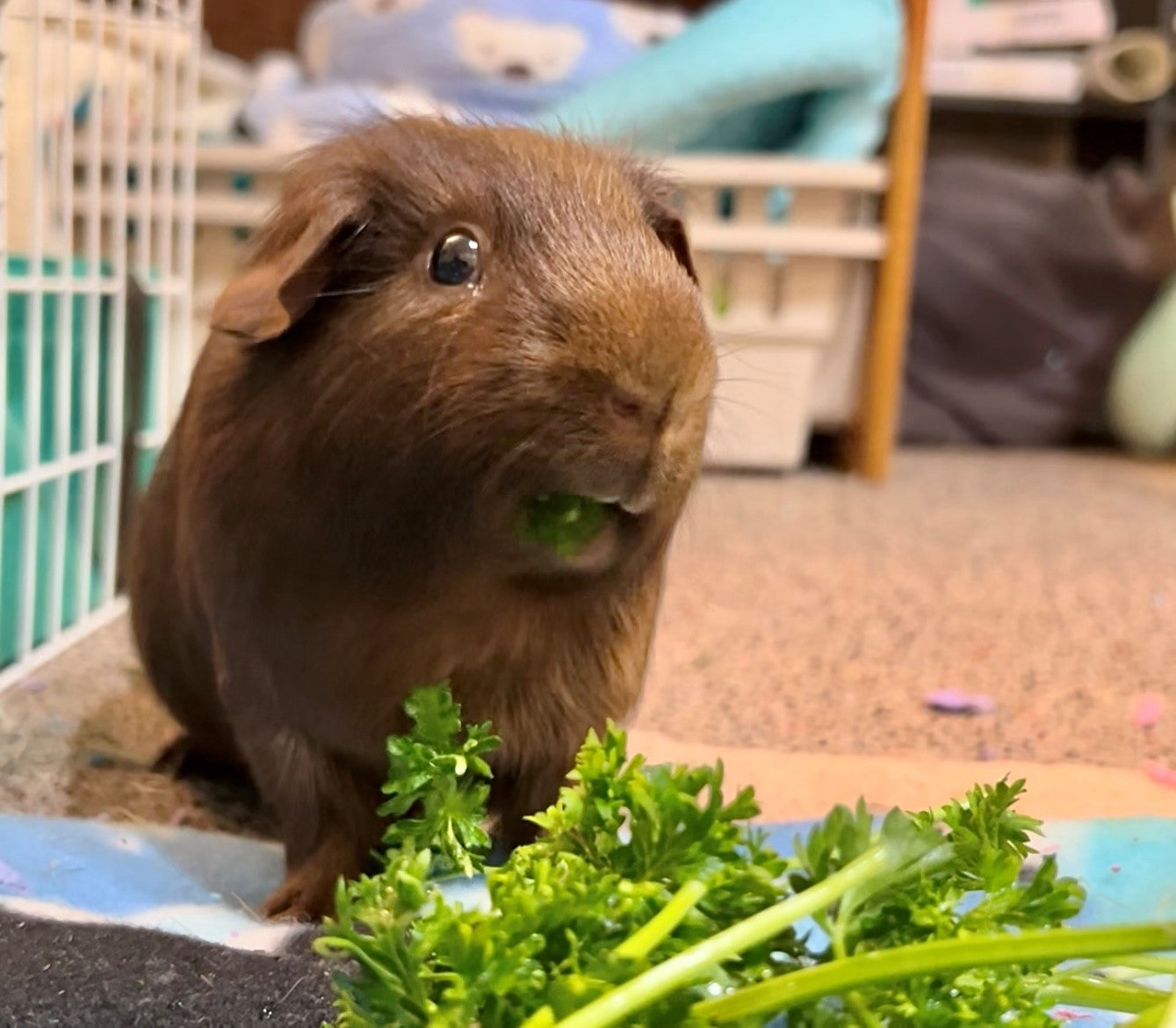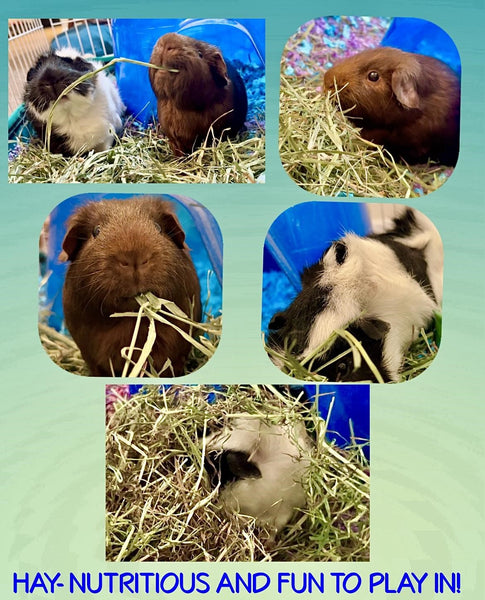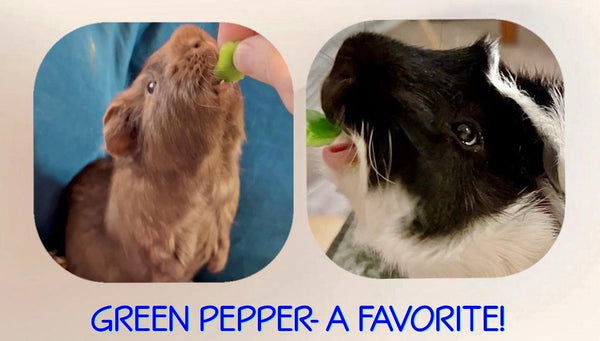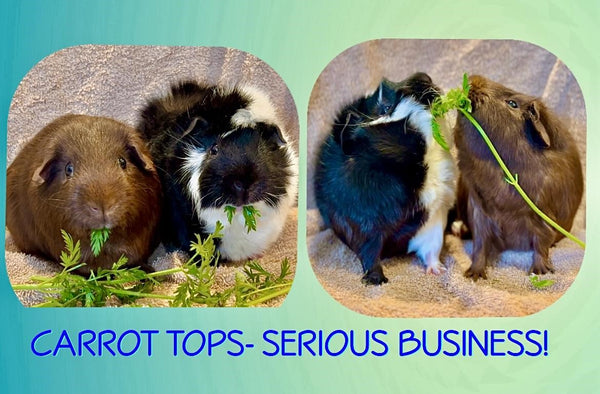
The Ultimate Guinea Pig Diet Guide
My dad used to call guinea pigs “eating machines”, and he wasn’t too far off with that assessment! But what is the proper diet needed to keep these wonderful furry companions in tip top shape?
>>> READ MY FIRST BLOG POST ABOUT GUINEA PIGS
HEY!! Guinea pigs need HAY!!
Piggies need fresh hay- and lots of it! It is generally agreed upon by leading guinea pig veterinarians that 70-75% of their diet should be made up of hay and it should also be always available for them. But why is hay so important? A guinea pig’s teeth never stop growing. It’s essential that they always have hay to eat in order to keep their teeth from overgrowing and potentially causing serious dental and health problems. Plus, guinea pigs like to forage and picking out their perfect pieces of hay gives them positive mental stimulation as well.
But what kind of hay?
For full grown adults, grass-based hay, such as timothy and orchard grass are ideal. If you have a pregnant or a younger piggy, clover and alfalfa are good choices as they contain an increased amount of protein and calcium - but they are not recommended for adults because too much protein and/or calcium can lead to very painful bladder stones, which many times require surgery to remedy. Some grain-based hays, like oat, can be a yummy treat, but contain lots of calories and as a result should be fed sparingly.

Guinea pig pellets
Because the quality of available hay is subject to many kinds of growing conditions that the weather causes, a good pellet supplement is important to assist with the hay in a guinea pigs' diet. You will want to buy timothy hay-based pellets in order to help avoid the risk of excess calcium consumption (found in other hays listed earlier). Veterinarians recommend purchasing plain pellets (nothing with added seeds, dehydrated vegetables, etc.) and feeding between 1.5 to 2 tablespoons per guinea pig a day.
Vitamin C
Did you know you have something in common with your guinea pig? Unlike most mammals, both humans and guinea pigs cannot produce their own vitamin C and thus must get their daily allowance from their diets. Usually enough vitamin C can be gotten through daily fresh vegetables and fruits, but having a vitamin C supplement on hand is a good idea. Most of the major pet store chains carry a tasty vitamin C supplement for your guinea pigs.
Some of the biggest dietary questions asked are, “What types of fruits and vegetables can I feed?” and “How much can I give?”
Starting with vegetables
If you have or have had a guinea pig, you know the sound of a bag opening can generate excitement from a piggy! In order to make sure that enough vitamin C is received by your guinea pig, veterinarians recommend each guinea pig get a good handful or two of fresh greens daily.
There are lots of opinions on what kind of vegetables are good and what aren’t. I’ll focus on what are generally considered good vegetables….
A list of yummy vegetable treats for your guinea pig includes:
- Bell peppers (e.g., red, green, yellow)
- Greens- Collars, Turnip, Dandelion,
- Green leaf lettuce
- Romaine lettuce
- Parsley
- Cilantro
- Kale
- Broccoli
- Brussels sprouts
- Carrots and carrot tops
Head lettuce is not recommended. The nutritional value is very low, and it fills the guinea pig up, essentially making head lettuce the guinea pig equivalent of eating “potato chips”.

Make sure the vegetables are fresh, I always say, “If you wouldn’t eat them, don’t feed them to your guinea pigs!” Also make sure all vegetables are thoroughly rinsed before feeding. Some veggies are higher in calcium than others (like romaine lettuce) so factor that in your selection as too much calcium over time can lead to problems like bladder stones.


Fruits
While many fruits are high in vitamin C, most are also high in sugar and also acidic (can upset the digestive system). As a result, a small amount can be fed, but only as an occasional treat. Some favorite fruits of guinea pigs include:
- Blueberry
- Kiwi
- Strawberry
- Orange
- Banana
Do not feed Avacodo as it is toxic to guinea pigs (and most other rodents)
Other treats
Unfortunately, there are a lot of commercially available treats marketed to guinea pigs that really are not good for them. Many contain lots of fats and sugars (and even some dairy - a big no no) and are low in fiber. It’s recommended by most veterinarians that a hay-based treat is best. Hay based treats are readily available at most pet stores. Even then, just feed sparingly as you don’t want the guinea pig to eat too many of the treats, thus reducing the amount of fresh hay or pellets they eat.
Dried edible flowers and leaves/branches from nontoxic plants, like willow and apple, are also fine and can provide mental stimulation for your guinea pig as well. Guinea pigs should never be fed any kind of pastas, meats, or dairy products.
If your guinea pig is offered a new type of food and doesn’t seem to like it, don’t give up, try again a different day. Often it takes a few tries for a guinea pig to take to a food.
Fresh Water
Water is very essential and fresh water (changed daily) should always be available. Both a guinea pig specific (rodent) water bottle of at least 12 ounces (341ml) per pair of guinea pigs or a water dish placed in the pen are acceptable. My experience is that most guinea pigs prefer using a water bottle but if using a dish, make sure the water stays clean (not soiled from any bedding or piggy poops).

As with any care- any specific questions or concerns should be addressed with a qualified guinea pig veterinarian. Hopefully, however, this blog entry will give you a great start to keeping your guinea pig happy and healthy through diet!
Guest Post by Craig N. - long time Guinea Pig parent, currently of Bentley and Cosmo (pictured above), and they invite you to follow their antics @ https://www.facebook.com/briochepig
Until next time….








 email us
email us